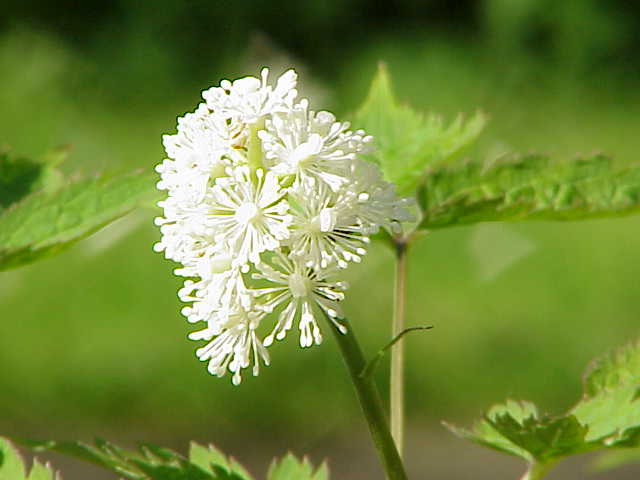- Red baneberry
Taxobox
name = "Red baneberry"

image_width = 200px
image_caption = "Actaea rubra "
regnum =Plant ae
divisio = Magnoliophyta
classis =Magnoliopsida
ordo =Ranunculales
familia =Ranunculaceae
genus = "Actaea "
species = "A. rubra"
binomial = "Actaea rubra"
binomial_authority = (Ait. )Willd.
subdivision_ranks = Subspecies
subdivision ="A. r. arguta" "A. r. rubra""Actaea rubra" (Red baneberry, Chinaberry, Doll's Eye) is a herbaceous
flowering plant native from northern and western America in the familyRanunculaceae .Description
These open woodland plants grow convert|40|cm|0|abbr=on to convert|80|cm|0|abbr=on tall.
The leaves that are coarsely toothed with deeply lobed margins. Plants commonly have hairy veins on the undersides of the foliage. Each stem will have either three leaves that branch near the top, or will have three compound leaves and one upright flowering stalk from one point on the main central stem.
Plants produce one to a few
ternate ly branched stems which bear clusters of flowers having 3 to 5 sepals that are petal-like and obovate in shape and remain after flowering. The petals are deciduous, falling away after flowering is done. They are clawed at the base and 2.5 mm to 4 mm long and spatulate to odovate in shape. Flowers have numerous stamens and the are white in color.After flowering green berries are produced. The fruits are ellipsoid shaped berries containing several seeds. [Gleason, H.A. 1978. "The new Britton and Brown illustrated flora of the northeastern United States and adjacent Canada. Volumes 2". Hafner Press, New York. Page 158.] In mid to late simmer, the berries turn bright red or white (forma "neglecta"). The berries also have a black dot on them.
Distribution
They are found growing in shady areas with moist to wet soils, open forest or dry slopes. In
Alaska it ranges from the Kenai Peninsula, through Kodiak Island, Bristol Bay, and up the Yukon River.Ecology
Plants are slow growing and take a few years to grow large enough to flower. The western subspecies is ssp. "arguta", and the northern subspecies is ssp. "rubra", [ [http://plants.usda.gov/java/profile?symbol=ACRU2 PLANTS Profile for Actaea rubra (red baneberry) | USDA PLANTS ] ] these subspecies are not well differentiated, and in many locations, each grades in to the other over much of their ranges. [ [http://www.efloras.org/florataxon.aspx?flora_id=1&taxon_id=233500024 Actaea rubra in Flora of North America @ efloras.org ] ] The foliage is rarely consumed by grazing animals. [ [http://www.fs.fed.us/database/feis/plants/forb/actrub/all.html Actaea rubra ] ] The poisonous berries are harmless to birds, the plants primary seed disperser. [Edible and Medicinal plants of the West, Gregory L. Tilford, ISBN 0-87842-359-1]
Uses
Plants are sometimes grown in shade gardens for their attractive berries and their upright clump forming habit.
Native Americans used the juice from the fruits of various baneberry species to poison arrows, and used the root as a herbal remedy for menstrual problems.
The root of this species has been used as a strong alternative to Black Cohosh, ("Cimicifuga racemosa") for menstrual cramping and menopausal discomfort.
Toxicity
All parts of the plant are poisonous. However, Accidental poisoning is not likely since the berries are extremely bitter.
The berries are the most toxic part of the plant. A healthy adult will experience poisoning from as few as 6 berries. Ingestion of the berries causes nausea dizziness, increased pulse and severe gastrointestinal discomfort. [Gibbons, J. Whitfield, Robert Haynes, and Joab L. Thomas. 1990." Poisonous plants and venomous animals of Alabama and adjoining states." Tuscaloosa: University of Alabama Press.] [Ewing, Susan. The Great Alaska Nature Factbook. Portland: Alaska Northwest Books, 1996.] The toxins can also have an immediate sedative affect on the cardiac muscle tissue possibly leading to cardiac arrest if introduced into the bloodstream. As few as 2 berries may be fatal to a child. [Ewing, Susan. The Great Alaska Nature Factbook. Portland: Alaska Northwest Books, 1996.]
The fruits and foliage contain ranunculine, [Duke, James A. 2001. "Handbook of phytochemical constituents of GRAS herbs and other economic plants". Herbal reference library. Boca Raton: CRC Press. ISBN 0849338654 page 13.] and are often reported to contain protoanemonin.
All parts of the plant contain an irritant oil that is most concentrated with in the roots and berries.
The roots contain β-sitosterol
glucoside . [Planta Med 2006; 72: 1350-1352]There have been no reported cases of severe poisoning or deaths in North America, but children have been fatally poisoned by its European relative "A. spicata", [Knight, Anthony P., and Richard G. Walter. 2001. "A guide to plant poisoning of animals in North America." Jackson, Wyo: Teton NewMedia. Page 85.] [Turner, Nancy J., and Nancy J. Turner. 1997. "Food plants of interior First Peoples". Royal British Columbia Museum handbook. Vancouver: UBC Press. Page 186.] It is claimed that poisoning is unlikely from eating the fruits of this species also [Frohne, Dietrich, and Hans Jürgen Pfänder. 2005. "Poisonous plants: a handbook for doctors, pharmacists, toxicologists, biologists, and veterinarians." London: Manson. Page 322.]
This plant closely resembles mountain sweetroot, ("Osmorhiza chilensis"), and can be confused with it, however, Red Baneberry lacks the strong anise-like "spicy celery" odor of mountain sweetroot. DOI: 10.1055/s-2006-951696]
References
External links
* http://www.swcoloradowildflowers.com/White%20Enlarged%20Photo%20Pages/actaea%20rubra.htm
Wikimedia Foundation. 2010.
